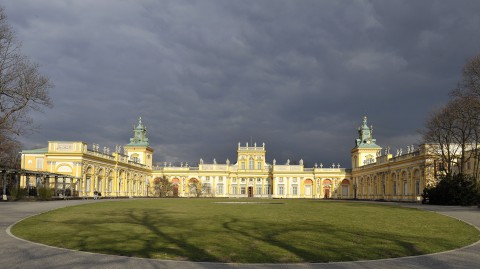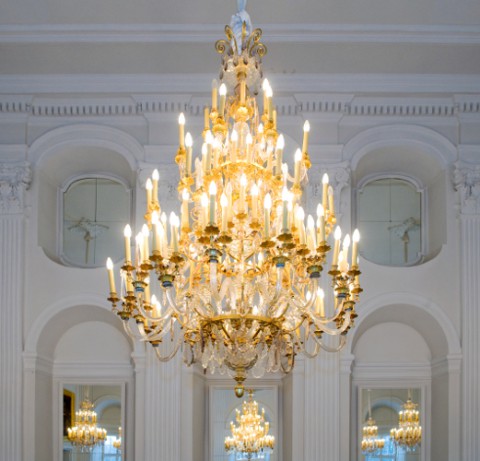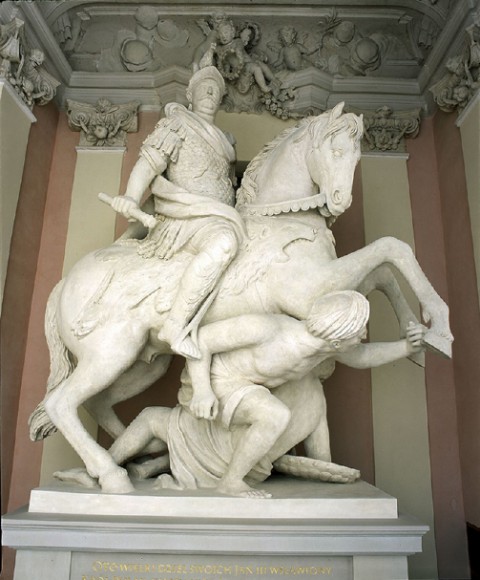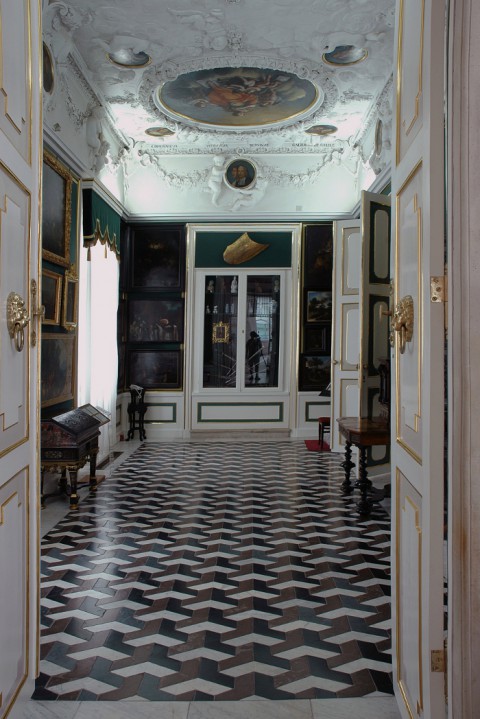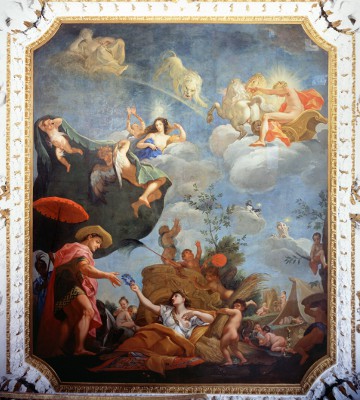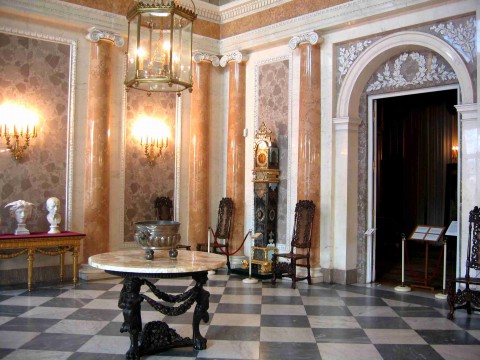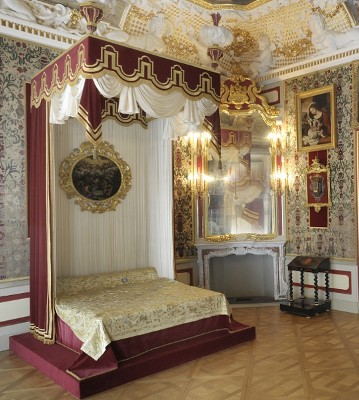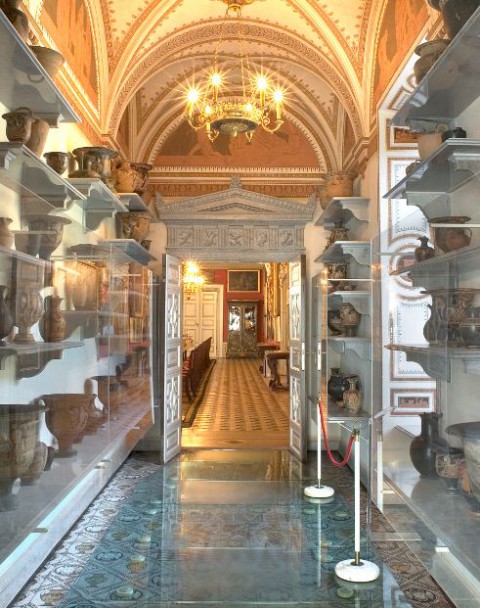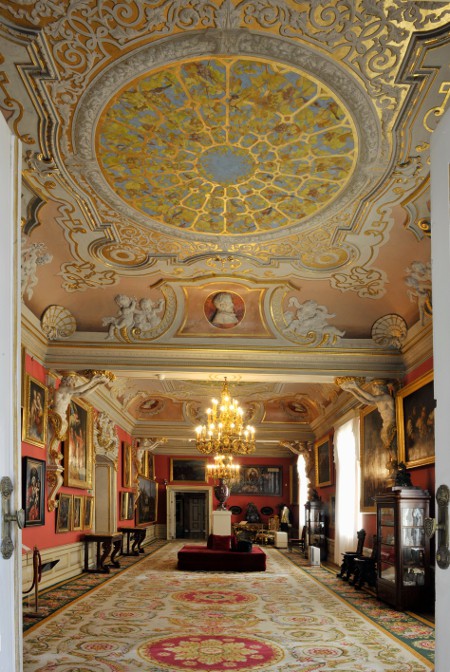Visit the palace
The history of the Wilanow Palace, a wonderful Baroque royal residence, began on April 23, 1677, when a village became the property of King John Sobieski III. At the beginning, the residence built there was small. Augustyn Locci, the king’s court architect, received the task of creating only a ground floor residence of a layout typical for the buildings of the Republic of Poland. However, military successes and an increase of the importance of royalty in the coming years had a huge influence on expanding the initial project. Huge construction works were conducted in the years 1677-1696. After completion, the building comprised of elements of a nobility house, an Italian garden villa and a French palace in the style of Louis XIV. After the death of the King, the Palace became the property of his sons, and in 1720, a run down property was purchased by one of the wealthiest women in Poland of those days – Elizabeth Sieniawska. In 1730, the Palace, for three years, was owned by king August II the Strong, who made considerable changes in the residence, particularly as far as the internal décor is concerned.
In the middle of 18th century, the Wilanów property was inherited by the daughter of Czartoryski, wife of a field marshal, Izabela Lubomirska, during whose reign, Wilanów started shining with its previous glory. Sixty nine years later, the Duchess gave Wilanów to her daughter and her husband, Stanislaw Kostka Potocki. Thanks to his efforts, one of the first museums in Poland was opened in the Wilanów Palace, in 1805.
The exposition consists of two parts: on the main floor you will be able to see the royal apartments of the palace. Rooms where parties took place, chambers where the royal couples listened to music, met their friends and guests, and where they worked and rested. On the first floor there is the Gallery of the Polish Portrait, where you can see the effigies of the Polish monarchs collected over the centuries, representatives of great magnate families, participants of national uprisings, eminent artists and people honored by Poland. Their authors are often prominent Polish and foreign painters.
TOP 10 - the most interesting rooms on the main floor:
The White Hall
Designed by J. Z. Deybl and completed in 1730-1733 for King August II, who used the Palace in Wilanów under a compact with the Czartoryski family, the White Room is the most sumptuous interior in the Palace, optically enlarged by great wall mirrors facing the windows. Aligned with the axis of the room are two fireplaces with surviving cast-iron plates carrying King August II’s initials. Above the fireplaces there are two orchestra boxes, formerly used by the court musicians and discovered after World War II as part of a conservation project. The walls are decorated with paintings of two monarchs from the Wettin dynasty, August II and August III. Both were painted by Louis de Silvestre. Next to the fireplace there is a porcelain figure of August III made in Meissen after a model by J. J. Kaendler, J. F. Eberlein and J. G. Ehder (1740/1741).
Statue of Jan III Sobieski
In the King’s day, his equestrian statue showing Jan III Sobieski as the triumphant vanquisher of the Turks, stood in a niche flanked by two columns opposite the main entrance to the Palace. The plaster statue was made around 1693 by an unknown royal sculptor. When the Grand Vestibule was being modified in 1729, the statue was moved to a new location near the south turret. A post-war conservation project revealed near the statue two plaster statues of Hercules, walled up in the 19th century and probably dating back to 1730-1733. Together with the ceiling painting “The Genius of Fame” (after a painting by Annibale Carracci in the Dresden Gallery), they formed an allusion to the King’s military exploits.
The Chapel
The Chapel was built in 1852-1861 on the initiative of Aleksandra Augustowa Potocka to commemorate Jan III Sobieski, who had died in Wilanów in 1696. It was designed in 1852 by Enrico Marconi and F. M. Lanci, architects of the Potocki family, working as a team. The altar with its tabernacle and the decoration of the walls, doors and windows was done by the Italian L. Carimini, and the statue of Virgin Mary (after Raphael’s Sistine Madonna) was made by the Italian sculptor V. Gaiassi. The stucco decorations of the dome were made by a local stucco worker, one Józef Klimczak from the village of Powsinek. The bronze door was cast in the Warsaw foundry of K. Minter (1852-1853), and the four bas-reliefs with Gospel scenes come from the Paris works of J. B. Lavastre (1853).
The King's Library
Once a two-part room connected by an arcade, this used to be Jan III’s refuge where he read and worked. It can boast of having the oldest authentic floor in the Palace, made of three-coloured marble tiles.The ceiling was decorated by the king’s court artists with tondo paintings depicting allegories of the two chief sciences of the 17th century, Philosophy and Theology, surrounded with medallion portraits of eminent scholars and artists of Antiquity and modernity, arranged in respective pairs and duly captioned.The room is decorated with several dozen paintings by Flemish, Dutch, French and German artists – exactly as it was in the times of King Jan III, according to a 17th-century inventory list.In the cabinet there is a miniature portrait of the king’s youngest son, Konstanty, made in 1682-1684 by an unknown court painter, Chinese porcelain (16th to 18th centuries) and European weapons (16th-17th century).
The King's Bedroom
This room is the structural equivalent of the Queen’s Bedroom on the other side of the Dutch Study. The ceiling painting by J.E. Siemiginowski depicts an allegory of Summer with Aurora bearing the features of Queen Marie Casimire. The decorative moulding between the ceiling and the walls include putti riding sea horses and dolphins and tondo pictures depicting summer works in the country, with matching quotations from Virgil’s Georgics on streamers. The Regency mirror frames are decorated with summer motifs. The walls are lined with velvet (ca. 1730) in the Genoan style.The interior is filled with 18th-century furniture: Louis XIV stools, a copy of a chest of drawers from the workshop of A. Boulle made for Cardinal Mazarin, bearing a gilt silver tray by J. G. Holl, an eminent goldsmith from Gdańsk, given to the King by the citizens of Kraków after his celebrated victory in the Battle of Vienna.
The Grand Vestibule
In the days of King Jan III, this was the largest room in the Palace, a two-storey space aligned with the main body of the edifice (it was originally used as a Dining Room), linking the royal rooms situated on its two sides: King Jan III’s rooms to the right of the entrance, and Queen Marie Casimire’s to the left.Late in the 17th century, an equestrian statue of King Jan III flanked by a pair of columns stood opposite the main entrance (in 1729 its was moved to a niche near the south turret). The walls used to be decorated with paintings depicting the triumphs of Alexander the Great. A plafond painting by J. E. Siemiginowski showed the allegory of “Night and Day”, and was surrounded with lavish stucco decorations (surviving to this day), illustrating the Four Elements (Earth, Water, Fire and Air) and the Four Winds in the corners.The present Classicist interior with marbled walls was designed in the last quarter of the 18th century by Sz. B. Zug, and executed by F. Baumann. The ceiling decoration and the canvas-painted frieze are by Enrico Marconi and his son Carlo (mid-19th century).The room is furnished with English chairs and armchairs (late 16th century) and a French table with an onyx tabletop, with an English lantern hanging over it.
The Queen's Bedroom
This is one of the most spectacular Baroque interiors in the Palace. The ceiling is decorated with a plafond painting by J. E. Siemiginowski (Allegory of Spring). The decorative moulding between the ceiling and the walls features sphinxes and putti as well as frescoes of the various kinds of springtime work in the country with matching quotations from Virgil’s Georgics on streamers. The Regency mirror frames are decorated with symbolic vernal motifs.The walls are covered in patterned velvet (1710-1730) in the Genoan style. The furniture includes a chest of drawers made in Boulle’s workshop (early 18th century) with a toilet set that once belonged to Queen Marie Casimire, a Dutch escritoire and a Baroque sofa with a set of Saxon cushioned stools covered in the same fabric as the walls. The silver inkwell on the table was made around 1700 by N. Schlaubitz in Gdańsk.The room is decorated with three mythological paintings above doors (workshop of L. de Silvestre) and “The Concert” after a fresco by Niccolo del' Abbate of Modena.
The North Gallery
The Lower North Gallery links the wing of the Palace with its main body. In 1820, Stanisław Kostka Potocki decided to use it as museum space and had the side adjacent to the Gardens walled up to half its height. Together with the rooms in the north wing, the Gallery formed part of Wilanów’s public collection of paintings. It was restored to its original shape in a post-war conservation project.The walls and ceilings are decorated with frescoes which emerged after the removal of a layer of plaster. Commissioned by King Jan III from Michelangelo Palloni (ca. 1688), they continue Apuleius’ story of Amor and Psyche (the beginning of the story is depicted on the ceiling frescoes in the south gallery). The ceiling paintings are separated by lavish stucco decorations with analogous scenes played by putti, with Latin captions on streamers.The murals opposite the Gallery windows are by Giuseppe Rossi and date back to the first half of the 18th century.The equestrian portrait of Stanisław Kostka Potocki, signed “J. L. David 1781” and exhibited at the closing end of the Gallery, is one of the most valuable items in the Wilanów collections. The Gallery also contains 18th- and 19th-century marble busts (copies of ancient originals) displayed on 19th century gilt consoles.
The Etruscan Cabinet
This was designed (post 1853) by Enrico and Leandro Marconi as an exhibition room for the Wilanów collection of ancient amphorae started by Stanisław Kostka Potocki. The collection, originally made up of ca. 100 items, is unique among contemporary Polish collections of this kind as it was gathered not only through purchases but also thanks to archaeological work personally led by Potocki in 1785/1786 at Nola near Naples. In 1853, August Potocki augmented the collection with a number of vases belonging to the Mikorski family, purchased together with their estates in Słubice near Gostynin.The decorative paintings in this room (probably by Carlo Marconi) and its tiled floor are an allusion to the art of Antiquity. The figurative scenes from Homer’s Odyssey are based on the engravings of Tomasso Piroli after drawings by John Flaxman; the mosaic-effect floor tiles were probably made in Berlin ca. 1850.Today, the permanent exhibition of Wilanów amphorae contains 84 ancient vessels from the 8th to the 2nd century BCE, mainly from south Italy, Etruria and Athens, and 27 copies from the end of the 18th century, mostly commissioned by Stanisław Kostka Potocki to be modelled on originals in his collection.
The Paintings Gallery called Museum
Originally a three-room apartment, August Potocki had it converted around the middle of the 19th century into a permanent museum gallery, mostly displaying foreign paintings. The Pompeii pink walls and the ceiling murals with medallion portraits of great sculptors, architects and painters of the Renaissance, Baroque and Classicist periods are an allusion to typical 19th century museum interiors. The walls are decorated with European paintings from the collection of Stanisław Kostka Potocki and his successors. The most valuable pieces include: “The Final Judgement” (1530) by Wolfgang Krodel the Elder and “Entry of Michał Radziwiłł to Rome” (probably 1680) by Pieter van Bloemen and possibly also Niccolo Viviani Codazzi.The exhibition also includes examples of fine craft work, such as two large cabinets containing silverware from the M.G. Biennais & J.B.C. Odiot works in Paris. One of the two smaller glazed cabinets situated between the windows displays 18th and 19th century bronzes and 17th to 19th-century stoneware tankards; the other – Böttger’s red stoneware from 1710-19 and 18th-century Meissen china and Dutch faience after Oriental patterns. The ormolu console contains a cast-iron fireplace clock with a pair of candlesticks, purchased by August Potocki in Paris in 1851, after the World Exhibition in London.
suggested

Proprietors of the palace: from a king to a custodian
The Wilanów Palace, its beautiful gardens and buildings located in the park as well as the amassed works of art all constitute records of history. The venue commemorates Jan III, a warrior-king and at the same time a lover of books and paintings, a well-educated patron of art vividly interested in science. His memory was kept alive by Stanisław Kostka Potocki, an outstanding politician and founder of the Wilanów Museum.

Wilanów Top 15
The Wilanów Top 15 presents the most valuable, extraordinary and beautiful works of art from the Wilanów Palace collection. The exhibits originate from all over the world, from ancient Rome through 17th-century Japan to ateliers of the French masters. Their history reflects the lives and fate of people related to the Wilanów residence. Get acquainted with the exhibits, view and admire them only to rediscover them later in the palace interiors.

Wilanów Residence
The Wilanów residence is composed of the palace, its decorations and works of art, gardens and sculptures located in the park and also numerous buildings and monuments raised in the location since 1677. A visit to Wilanów, be it virtual or real, provides an opportunity to experience the core of our tradition that is also a part of the common European culture.

Portrait of Stanisław Kostka Potocki
Here is a story about an equestrian portrait of Stanisław Kostka Potocki, a scholar, traveller and politician, creator of the Wilanów Museum, which for over 200 years has been open to the public.

Patronage of King Jan III
Popular opinion presents Jan III as a warrior king who defended Latin Europe against Ottoman invaders. It is therefore worth recalling that he was also a connoisseur of art and a great lover of books. In his leisure time he would indulge in reading and hold erudite discussions with his secretaries and visitors who came to Wilanów from different parts of the world.


